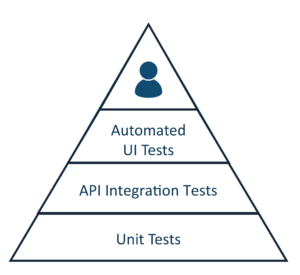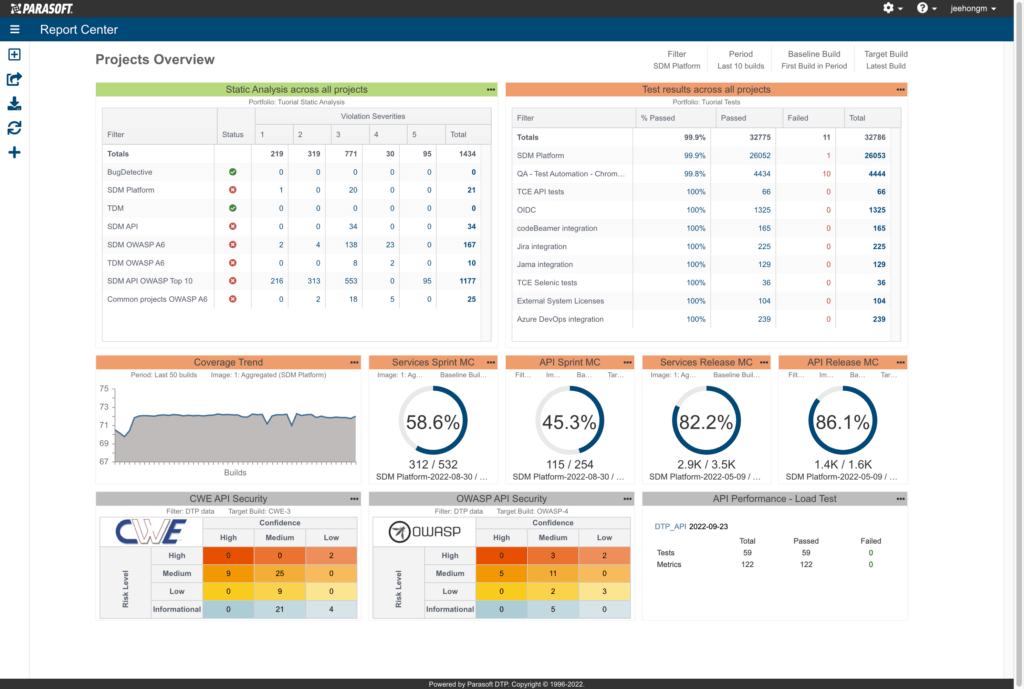Use Agentic AI to generate smarter API tests. In minutes. Learn how >>
Jump to Section
Modern Analytics for Modern Software Testing
Having visibility into key metrics helps dev and test teams make well-informed decisions to release high-quality software on time and on budget. Read on to learn what metrics are important to track.
Jump to Section
Jump to Section
Driving a car without clear visibility is not only dangerous but also reckless. It puts you and everyone around you at risk of collisions, injuries, and even fatalities. Without being able to see the road ahead, you cannot anticipate potential hazards or obstacles, making it impossible to make informed decisions and take appropriate actions.
Similarly, developing software without adding visibility to the process is like driving blindly. Software metrics provide the needed visibility to identify potential quality and security issues that need immediate attention so you can decide when to keep pushing hard and when to slow down.
Taking it a step further, analytics and intelligent software help you to:
- Understand the metrics.
- Assess risk.
- Measure quality.
- Predict outcomes.
- Collaborate effectively with your team.
All of this helps teams to:
- Meet deadlines.
- Deliver high-quality products.
- Satisfy customers.
How to Plan Modern Software
Modern software projects are usually planned out by weighing the cost of user stories to be committed against the capacity of the team. Usually, these stories are captured in tools like Jira, GitHub, or Azure DevOps.
Product managers negotiate with development managers to determine what can realistically be done in the current release cycle. Next, development managers can plan based on:
- New requirements.
- Existing issues to fix.
- Potential technical debt to tackle.

Plans, of course, are subject to change. Most software projects run into issues or roadblocks that can alter the outcome of the plan. Security vulnerabilities in particular can be a major setback. Disruptions are inevitable, but without being able to measure the impact, it becomes difficult to rein in the project.
Visibility With Quick Access
Visibility is essential for developing software. Monitoring tools and analytics provide insights to make safe and effective decisions.
Quick access to software development metrics in an easy-to-use dashboard is important for understanding software development status and progress. Having quick access through visual tools like dashboards enables Agile development teams to:
- Identify trends, patterns, and issues that may require attention via a single, consolidated view of key metrics.
- Make informed decisions in a timely manner from real-time updates on software development metrics.
- Understand complex data in a more intuitive and visually appealing way.
What Metrics Are Important to Track?
Metrics are usually collected at points where software test automation tools are “touching” the code. Typically, collecting occurs during static analysis and test execution. Details collected can be cross-referenced to, for example, files, particular tests, known security vulnerabilities or software weaknesses, and requirements.
Static Analysis Results
When I first started as a developer, I was skeptical about the benefits of static analysis. I did it just because it was a company policy. Over the years, I’ve come to appreciate its benefits. Static analysis consistently detects certain issues that would not have been caught otherwise and have manifested as defects for customers. The benefits outweigh the inconvenience of having to suppress the inevitable false positives of static analysis.
Static analysis helps shift security and code quality considerations earlier in the software development life cycle, enabling developers to address issues before they become more expensive and time-consuming to fix.
By integrating static analysis into the development process, developers can identify and fix security issues before they affect end users. For certain safety-critical industries, static analysis is a must-have to keep your codebase compliant with coding and industry guideline requirements.

The metrics from static analysis can provide valuable insights into the state of the application’s quality and security posture, helping organizations better plan their software development efforts. Metrics like the number of defects, their severity, and their location within the codebase can help teams prioritize issues and allocate resources accordingly. You can track progress over time and identify areas for improvement.
Static analysis also helps with standards compliance. Metrics collected provide organizations with the data they need to demonstrate compliance with industry or regulatory standards.
Test Results
Test results are the most important metrics (yes, the most important) for software development teams. If tests are failing, something is wrong and requires immediate attention. There are different types of tests. Teams should gather and review metrics for each type every day.
Unit Tests
Unit tests are the foundational building blocks of your test suite. The primary benefits are:
- Ensure the unit of code works properly.
- Run with every build of your code once they’re checked in and ensure the unit keeps working.
- Run fast meaning they can be run frequently while writing new code or modifying existing code.
- Allow you to refactor code with confidence.
- Automatically force you to write testable code.
- Enable you to easily measure code coverage. Most frameworks make this quite easy.
API Integration Tests
Integration tests determine if independently developed units of software work correctly when they’re connected to each other. API tests are one type of integration test.
There’s a phrase that’s popular in software development: Integrate early, integrate often.
Integration tests are a must to realize the full benefit from this practice. They’re more difficult to write than unit tests. However, leveraging a good testing tool or framework definitely helps. And it takes more work to measure code coverage while running integration or API tests.
UI Tests
UI tests are another type of test that drives the application through the user interface. These are valuable. If you can automate UI tests, then you save your team from having to run manual tests again and again.
These tests are the most difficult to write and can be costly to maintain. Running them also requires an investment in a testing infrastructure where you can run them with certain browsers or in headless mode. Measuring code coverage also requires investment.
Note that Parasoft offers tools and frameworks for each of these test types, making it easier for you to write and maintain these tests, as well as measure code coverage while running them.
Manual Tests
Lastly, manual tests require your quality assurance (QA) team to manually validate the software’s functionality from the end user’s perspective. The results of manual tests can provide insights into the usability and user experience of the software, highlighting areas where improvements may be necessary.

Code Coverage
Code coverage is a metric that goes hand in hand with your test results. You may have 100% passing tests, but if only 5% of your codebase is tested, you’re still driving blind.
Before a road trip, you’d feel more assured if your car passed a 150 point car inspection versus only a 10 point car inspection. In the same way, code coverage is a useful metric that correlates with the depth and quality of your test suite.
What’s a good coverage? It depends.
If you’re starting a new project, it’s reasonable to aim for 80% code coverage or higher from the beginning. This will mean that 80% of your code base is tested. If your codebase is a mix of new code and some legacy code, it may be difficult to enforce 80% code coverage. In this case, you can track two other metrics:
- Code coverage trend
- Modified code coverage
Coverage Trend & Modified Code Coverage
If your overall code coverage is low when you start, let’s say 10%, then it may be unreasonable to try to get to 80% code coverage. However, it is reasonable to make sure that your code coverage is always improving over time.
You improve code coverage over time by tracking the trend. Along with that, a practice that Parasoft recommends is measuring modified code coverage. This is a subset of your overall code coverage—just the code coverage of code that has changed since you started measuring code coverage.
Parasoft recommends setting a goal of 80% modified code coverage. By adopting this practice, you can ensure that your overall code coverage keeps improving toward that 80% goal even if you start at a low overall code coverage.
Different Types of Coverage
For many organizations, measuring line coverage may be sufficient. But for certain safety-critical industries, measuring line coverage is not sufficient. Safety standards like ISO 26262, IEC 62304, and DO-178C require evidence of sufficient code coverage metrics such as statement, branch, MC/DC, and others. Tools that are TÜV SÜD certified for these standards, like Parasoft C/C++test, have the ability to measure advanced code coverage metrics.
Putting It All Together
Now that you know what metrics are important to track, you want easy and quick visibility of these metrics. Parasoft DTP is a dashboard and reporting tool that gives you visibility into all these metrics, so you don’t have to drive blind.

Development teams can use dashboards like this during daily standup meetings and to show the project’s quality status to stakeholders during sprint reviews.
Quality and compliance teams can use dashboards to continuously monitor their compliance efforts to certain industry standards. Take a quick tour of DTP to see how development teams get full visibility.
Better Quality Drives Value
When you have visibility into key quality metrics, you won’t have to drive blind. Instead, at every step, you can make well-informed decisions that show results.
- Release on time and on budget.
- Fewer support issues.
- Improve customer satisfaction.
- Increase brand reputation.
Why drive blind when you can have visibility?



